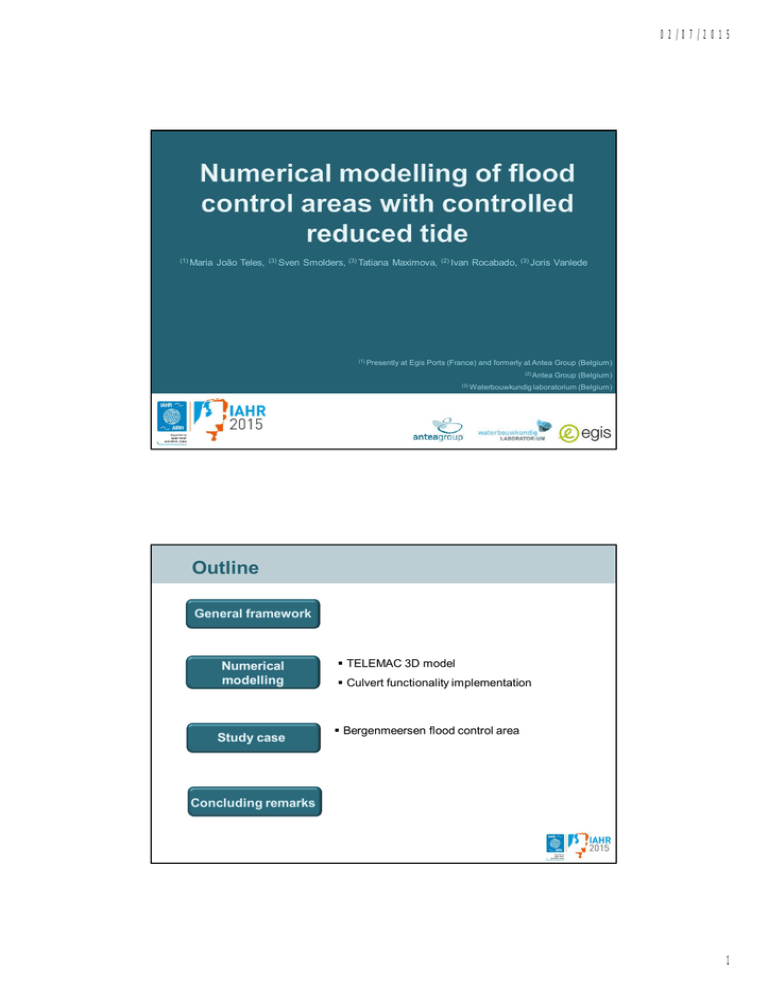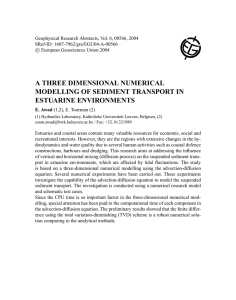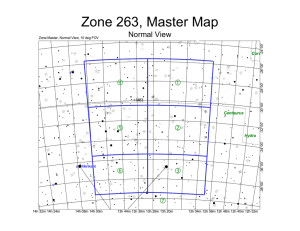02/07/2015
advertisement

02/07/2015 (1) Maria João Teles, (3) Sven Smolders, (3) Tatiana Maximova, (1) Presently (2) Ivan Rocabado, (3) Joris Vanlede at Egis Ports (France) and formerly at Antea Group (Belgium) (2) Antea Group (Belgium) (3) Waterbouwkundig laboratorium (Belgium) Outline General framework Numerical modelling Study case TELEMAC 3D model Culvert functionality implementation Bergenmeersen flood control area Concluding remarks 1 02/07/2015 General Framework 1/3 Motivation “Integrated Plan Upper Sea Scheldt” SCALDIS Understanding of hydrodynamics Integration of future navigability Conservation of ecological functioning and safety General Framework 2/3 Flood control areas (FCA) with Controlled Reduced Tide (CRT) function hriver > hFCA Water flows over the dyke hriver < hFCA Water flows through the outlet With CRT funtion: hriver > hFCA and hriver < hdyke_crest Water flows through the inlet hriver < hFCA Water flows through the outlet hriver > hFCA and hriver > hdyke_crest Water flows through the inlet and over the dyke 2 02/07/2015 General Framework 3/3 Flood control areas (FCA) with Controlled Reduced Tide (CRT) function www.sigmaplan.be - In 2013, 13 areas were already activated - In 2040 more than 40 areas will be activated Main target Implementation of a culvert functionality • Model water flow through culverts; • Verify and validate model results during storm surge event Numerical modelling 1/5 TELEMAC-3D (Hervouet, 2007) Circulation hydrodynamic model 3D RANS equations with a free surface With or without hydrostatic hypothesis Finite elements method Open source (since July 2011) 3 02/07/2015 Numerical modelling 2/5 Culvert functionality implementation – TELEMAC-3D (version v6p3) - If water flows from the river to the floodplain: Qfloodplain= - Qriver Source Sink + Source/ Sink term - If water flows from the floodplain to the river: Qriver= - Qfloodplain Source Sink Numerical modelling 3/5 Culvert functionality – theoretical framework Bodhaine (1968) : 4 02/07/2015 Numerical modelling 4/5 Culvert functionality – theoretical framework Bodhaine (1968) : Numerical modelling 5/5 Culvert functionality – theoretical framework Head losses due: - entrance, contraction of the flow (C1) friction (C2) outlet, expansion of the flow (C3) valve (Cv) trash screens (CT) entrance pilars (CP) 5 02/07/2015 Study case 1/6 Bergenmeersen area SCALDIS Two periods: - 10th to 12th September 2014 (13h campaign) - 5th to 7th December 2013 (Storm surge) Study case 2/6 Model setup Mesh size 5 - 20 m t= 5 s n (Manning)=0.016 Nz= 5 horizontal plans k- turbulence model 6 02/07/2015 Study case 3/6 Water levels 10th to 12th September 2014 (13h campaign) Scheldt river Inside the FCA Study case 4/6 Inlet discharge 10th to 12th September 2014 (13h campaign) 7 02/07/2015 Study case 5/6 Outlet discharge 10th to 12th September 2014 (13h campaign) Study case 6/6 Water levels 5th to 7th December 2013 (Storm surge) Scheldt river Inside the FCA Dyke overflow 8 02/07/2015 Concluding Remarks 1/1 Concluding remarks TELEMAC-3D is able to model flows through culverts; TELEMAC-3D can now take into account flood control areas with controlled reduced tide; Model results were verified against data measurements; Numerical results agree fairly well with measurements when storm surges are modelled. 9





